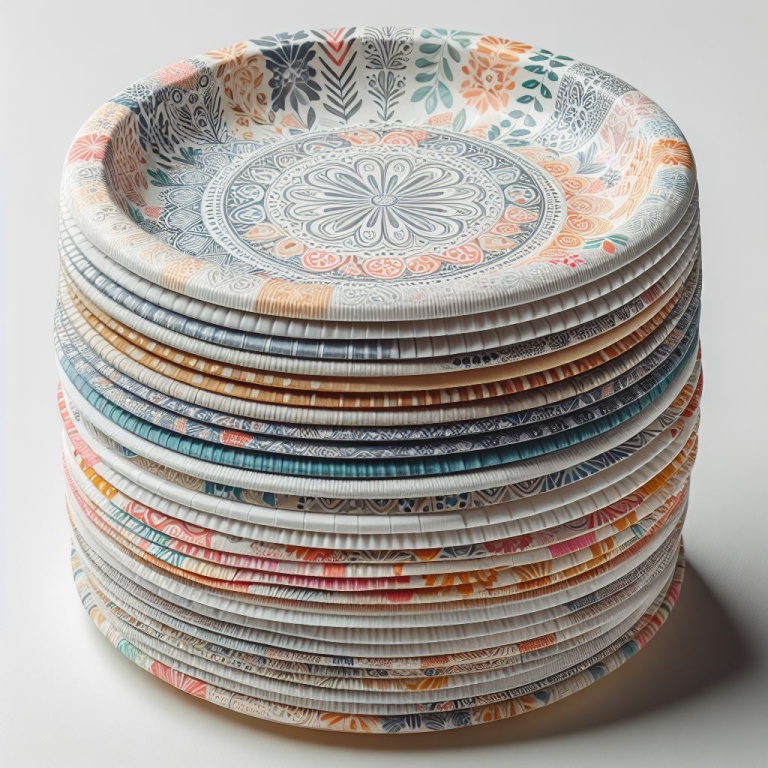Introduction to Paper Plate & Dona
Disposable paper plates and Dona, as the name suggests, are made of special quality paper reinforced with polythene sheets to prevent leaks. Paper Plates commonly used for serving food during family gatherings, snacks, fruits, sweets, and more. Sweet shops often use them for serving dry and wet sweets, while caterers use them for parties and social events. These products offer several advantages over traditional crockery and utensils. Unlike conventional utensils that require careful handling, cleaning, and storage space, disposable plates and bowls are lightweight, easy to handle, and can be disposed of after use. They're also cost-effective and easy to store also. Made by fusing two layers of high-quality paper with a polythene sheet, they can be manufactured in various shapes and sizes based on the desired design. The quality of paper used is crucial to ensure the plates maintain their shape and withstand the weight of the food served in them.
Market Potential Analysis for Paper Plates & Dona
Paper Plate products cater to both urban and rural markets, commonly used during social events, religious gatherings, parties, weddings, outings, in sweet shops, and by caterers. They offer numerous advantages over traditional utensils, as they can be easily disposed of after use, saving labor on cleaning and drying. They are also portable and easy to handle. In our country, where people frequently organize social gatherings and celebrations, there is a constant demand for these products. With a large population that regularly hosts weddings, birthdays, and family functions, the market for disposable plates and bowls is extensive, not only in urban but also in rural areas.Paper Plate Manufacturing Process Overview
The manufacturing process is relatively simple. A specific die is used to shape the product, which is made from Silver Paper Dona paper rolls cut to size or purchased according to production requirements. The die is heated to the desired temperature and mounted on a press. The paper rolls are placed between the male and female die parts, pressure is applied to shape the product, and then it is removed. This process is repeated with each set of paper rolls. The machine used is a standard press with a fixed platform and a moving plunger, operated hydraulically. Once formed, the products are collected, and their edges are trimmed for proper shaping. Plates and bowls are packed separately and stored for dispatch. Machinery suppliers provide necessary know-how, and all machinery is domestically available. The production capacity is estimated at 20,000-50,000 units per day for 365 days per year.Details of Machinery Used
In the realm of paper plate production, the machinery employed plays a pivotal role in ensuring efficiency, precision, and quality. Let's delve into the fascinating world of these specialized machines and uncover the intricate details of their operation.Hydraulic Paper Plate Making Machine
Semi-Automatic Paper Plate Making Machine
Fully Automatic Paper Plate Making Machine
Plate Lamination Machine
Paper Plate & Dona License Registration Process
- Determine the form of business and register accordingly.
- Apply for Trade License/Factory License from the Municipal Authority.
- Additionally, apply for MSME Udyog Aadhaar online registration.
- Obtain GST registration.
- Complete Fire/Pollution Registration as required.
- Choose a brand name for the product and secure the name with a trademark if necessary.

FAQ for How to make paper plate
1. Can I use any type of paper to make paper plates?- While you can use various types of paper, it's best to choose sturdy materials like cardstock or heavyweight paper to ensure the plates hold their shape and can withstand the weight of food.
2. Are homemade paper plates as durable as store-bought ones?- Homemade paper plates can be quite sturdy if made correctly with the right materials and techniques. However, they may not be as durable as store-bought plates designed specifically for repeated use.
3. Can I decorate homemade paper plates with food-safe materials?- Yes, you can decorate paper plates with food-safe markers or paints labeled as non-toxic. Avoid using materials that may contain harmful chemicals if they come into contact with food.
4. How can I make my paper plates more environmentally friendly?- Opt for recycled paper or biodegradable materials when making paper plates. Additionally, encourage reuse and proper disposal methods, such as composting or recycling.
5. Are homemade paper plates suitable for hot or oily foods?- Homemade paper plates may not be as suitable for hot or oily foods compared to store-bought plates designed for such purposes. Consider using a liner or doubling up the plates for added durability.
6. Can I wash and reuse homemade paper plates?- While some homemade paper plates may withstand gentle washing, they are generally intended for single-use purposes. Reusing them extensively may compromise their integrity and hygiene.
7. How can I ensure my homemade paper plates hold up well during use?- Ensure you fold and shape the paper plates carefully, using firm creases and secure adhesive if necessary. Using thicker paper and reinforcing the edges can also help improve durability.
8. Can children help make paper plates safely?- Yes, children can participate in making paper plates under adult supervision. Provide age-appropriate tools and materials, and ensure they handle scissors and other sharp objects safely.
9. Are there any creative ways to use homemade paper plates other than for serving food?- Absolutely! Homemade paper plates can be used for various crafts, such as creating masks, wreaths, or even as canvases for artwork. Let your imagination run wild!
10. How long does it take to make homemade paper plates?- The time required to make homemade paper plates depends on factors such as the number of plates you're making, your skill level, and the complexity of your designs. On average, it may take anywhere from a few minutes to half an hour per plate.